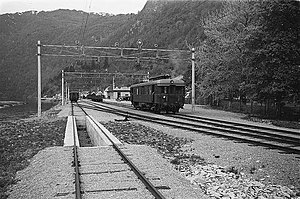NSB Class 64
| NSB Class 64 | |
|---|---|

Class 64 at Granvin Station in 1939
|
|
| In service | 1934–1985 |
| Manufacturer | NEBB and Strømmen |
| Constructed | 1934 |
| Number built | 3 |
| Capacity | 38 |
| Operator(s) | Norwegian State Railways |
| Specifications | |
| Car length | 16,300 mm (53 ft 6 in) |
| Maximum speed | 50 km/h (31 mph) |
| Traction system | 4 × NEBB EDTM 384 |
| Power output | 464 kW (622 hp) |
| Electric system(s) | 15 kV 16 2⁄3 Hz AC Catenary |
| Current collection method | Pantograph |
| Track gauge | 1,435 mm (4 ft 8 1⁄2 in) |
NSB Class 64 (Norwegian: NSB type 64) is a class of three electric multiple units built by Strømmens Værksted for the Norwegian State Railways. Delivered in 1935, they were built for the opening of the Hardanger Line and served there until 1985, when the line closed and the trains were retired. They also periodically served on the Flåm Line. The delivery consisted of three motor cars and four carriages, with each train consisting of up to three units. The motor cars were 16.3 meters (53 ft) long, had a power output of 464 kilowatts (622 hp) and were capable of 50 km/h (31 mph). The motor units were given road numbers 505 through 507. Two of the units have been preserved by the Norwegian Railway Club and are at Garnes Station.
The Hardanger Line opened in 1935 as a steep and curvy branch of the Bergen Line to connect Bergen to the Hardangerfjord. The line was 27.45 kilometers (17.06 mi) long, had a maximum gradient of 4.5 percent, a minimum curve radius of 180 meters (591 ft), a maximum speed of 40 km/h (25 mph), a maximum permitted axle load of 12 tonnes (12 long tons; 13 short tons), standard gauge and a 15 kV 16 2⁄3 Hz AC electrification system. In 1931, NSB had taken delivery of its first electric multiple unit, the Class 62, for use on commuter trains on the Drammen Line. For the Hardanger Line, NSB ordered similar units, but these were modified to have a higher power output. Three motor cars and four carriages were delivered in 1934. The mechanical components and assembly were done by Strømmens Værksted, while the electrical equipment was made by Norsk Elektrisk & Brown Boveri (NEBB). The class was similar to the future Class 65, and was regarded as a prototype. Class 64 were the shortest multiple units ever used by NSB.
...
Wikipedia
